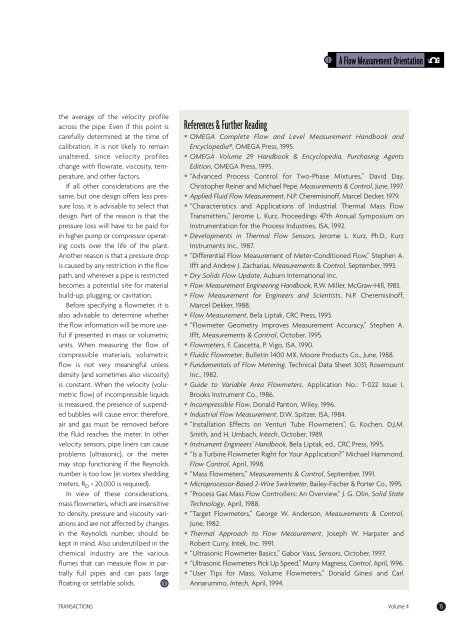flow and level measurement - Omega Engineering
flow and level measurement - Omega Engineering
flow and level measurement - Omega Engineering
Create successful ePaper yourself
Turn your PDF publications into a flip-book with our unique Google optimized e-Paper software.
the average of the velocity profile<br />
across the pipe. Even if this point is<br />
carefully determined at the time of<br />
calibration, it is not likely to remain<br />
unaltered, since velocity profiles<br />
change with <strong>flow</strong>rate, viscosity, temperature,<br />
<strong>and</strong> other factors.<br />
If all other considerations are the<br />
same, but one design offers less pressure<br />
loss, it is advisable to select that<br />
design. Part of the reason is that the<br />
pressure loss will have to be paid for<br />
in higher pump or compressor operating<br />
costs over the life of the plant.<br />
Another reason is that a pressure drop<br />
is caused by any restriction in the <strong>flow</strong><br />
path, <strong>and</strong> wherever a pipe is restricted<br />
becomes a potential site for material<br />
build-up, plugging, or cavitation.<br />
Before specifying a <strong>flow</strong>meter, it is<br />
also advisable to determine whether<br />
the <strong>flow</strong> information will be more useful<br />
if presented in mass or volumetric<br />
units. When measuring the <strong>flow</strong> of<br />
compressible materials, volumetric<br />
<strong>flow</strong> is not very meaningful unless<br />
density (<strong>and</strong> sometimes also viscosity)<br />
is constant. When the velocity (volumetric<br />
<strong>flow</strong>) of incompressible liquids<br />
is measured, the presence of suspended<br />
bubbles will cause error; therefore,<br />
air <strong>and</strong> gas must be removed before<br />
the fluid reaches the meter. In other<br />
velocity sensors, pipe liners can cause<br />
problems (ultrasonic), or the meter<br />
may stop functioning if the Reynolds<br />
number is too low (in vortex shedding<br />
meters, R D > 20,000 is required).<br />
In view of these considerations,<br />
mass <strong>flow</strong>meters, which are insensitive<br />
to density, pressure <strong>and</strong> viscosity variations<br />
<strong>and</strong> are not affected by changes<br />
in the Reynolds number, should be<br />
kept in mind. Also underutilized in the<br />
chemical industry are the various<br />
flumes that can measure <strong>flow</strong> in partially<br />
full pipes <strong>and</strong> can pass large<br />
floating or settlable solids. T<br />
1 A Flow Measurement Orientation<br />
References & Further Reading<br />
• OMEGA Complete Flow <strong>and</strong> Level Measurement H<strong>and</strong>book <strong>and</strong><br />
Encyclopedia®, OMEGA Press, 1995.<br />
• OMEGA Volume 29 H<strong>and</strong>book & Encyclopedia, Purchasing Agents<br />
Edition, OMEGA Press, 1995.<br />
• “Advanced Process Control for Two-Phase Mixtures,” David Day,<br />
Christopher Reiner <strong>and</strong> Michael Pepe, Measurements & Control, June, 1997.<br />
• Applied Fluid Flow Measurement, N.P. Cheremisinoff, Marcel Decker, 1979.<br />
• “Characteristics <strong>and</strong> Applications of Industrial Thermal Mass Flow<br />
Transmitters,” Jerome L. Kurz, Proceedings 47th Annual Symposium on<br />
Instrumentation for the Process Industries, ISA, 1992.<br />
• Developments in Thermal Flow Sensors, Jerome L. Kurz, Ph.D., Kurz<br />
Instruments Inc., 1987.<br />
• “Differential Flow Measurement of Meter-Conditioned Flow,” Stephen A.<br />
Ifft <strong>and</strong> Andrew J. Zacharias, Measurements & Control, September, 1993.<br />
• Dry Solids Flow Update, Auburn International Inc.<br />
• Flow Measurement <strong>Engineering</strong> H<strong>and</strong>book, R.W. Miller, McGraw-Hill, 1983.<br />
• Flow Measurement for Engineers <strong>and</strong> Scientists, N.P. Cheremisinoff,<br />
Marcel Dekker, 1988.<br />
• Flow Measurement, Bela Liptak, CRC Press, 1993.<br />
• “Flowmeter Geometry Improves Measurement Accuracy,” Stephen A.<br />
Ifft, Measurements & Control, October, 1995.<br />
• Flowmeters, F. Cascetta, P. Vigo, ISA, 1990.<br />
• Fluidic Flowmeter, Bulletin 1400 MX, Moore Products Co., June, 1988.<br />
• Fundamentals of Flow Metering, Technical Data Sheet 3031, Rosemount<br />
Inc., 1982.<br />
• Guide to Variable Area Flowmeters, Application No.: T-022 Issue I,<br />
Brooks Instrument Co., 1986.<br />
• Incompressible Flow, Donald Panton, Wiley, 1996.<br />
• Industrial Flow Measurement, D.W. Spitzer, ISA, 1984.<br />
• “Installation Effects on Venturi Tube Flowmeters”, G. Kochen, D.J.M.<br />
Smith, <strong>and</strong> H. Umbach, Intech, October, 1989.<br />
• Instrument Engineers’ H<strong>and</strong>book, Bela Liptak, ed., CRC Press, 1995.<br />
• “Is a Turbine Flowmeter Right for Your Application?” Michael Hammond,<br />
Flow Control, April, 1998.<br />
• “Mass Flowmeters,” Measurements & Control, September, 1991.<br />
• Microprocessor-Based 2-Wire Swirlmeter, Bailey-Fischer & Porter Co., 1995.<br />
• “Process Gas Mass Flow Controllers: An Overview,” J. G. Olin, Solid State<br />
Technology, April, 1988.<br />
• “Target Flowmeters,” George W. Anderson, Measurements & Control,<br />
June, 1982.<br />
• Thermal Approach to Flow Measurement, Joseph W. Harpster <strong>and</strong><br />
Robert Curry, Intek, Inc. 1991.<br />
• “Ultrasonic Flowmeter Basics,” Gabor Vass, Sensors, October, 1997.<br />
• “Ultrasonic Flowmeters Pick Up Speed,” Murry Magness, Control, April, 1996.<br />
• “User Tips for Mass, Volume Flowmeters,” Donald Ginesi <strong>and</strong> Carl<br />
Annarummo, Intech, April, 1994.<br />
TRANSACTIONS Volume 4 15

















